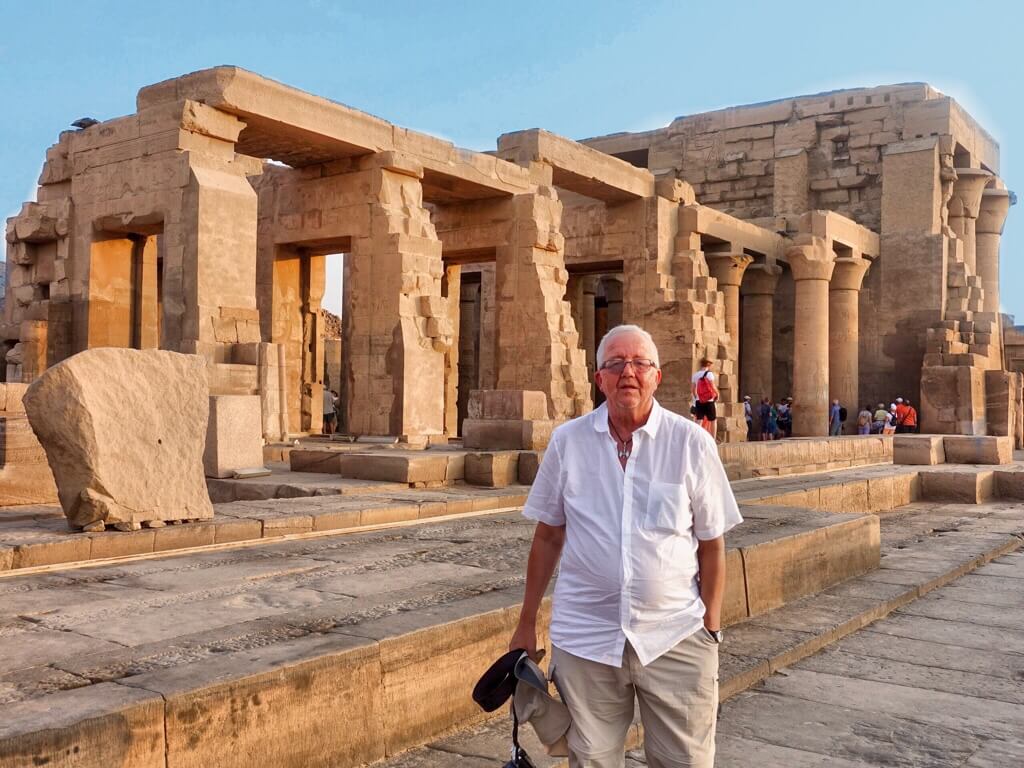






The Kom Ombo Temple is unusual in that it is a double temple, with one side dedicated to the god Haroesis and the other side to Sobek. The design is almost perfectly symmetrical, with two side-by-side sanctuaries and two parallel passageways leading through the outer parts of the temple.The right side is dedicated to Sobek-Re (the crocodile god combined with the sun god Re), along with his wife (a form of Hathor) and their son Khonsu-Hor. Sobek is associated with Seth, the enemy of Horus. In the myth of Horus and Osiris, Seth and his followers changed themselves into crocodiles to escape. The ancient Egyptians believed that by honoring the fearsome crocodile as a god, they would be safe from attacks. The left side is dedicated to Haroeris, the “Good Doctor” (a form of the falcon-headed god Horus the Elder) along with his consort Ta-Sent-Nefer, the “Good Sister” (another form of Hathor). Sobek is associated with the Nile crocodile and is either represented in its form or as a human with a crocodile head. Sobek was also associated with pharaonic power, fertility, and military prowess, but served additionally as a protective deity with protective qualities, invoked particularly for protection against the dangers presented by the Nile river. During the New Kingdom, Sobek was worshiped as the manifestation of Amun-Ra, the King of Gods, and was integrated into the cult of Amun. Sobek was often depicted wearing Amun’s headdress or Ra’s sun disk.
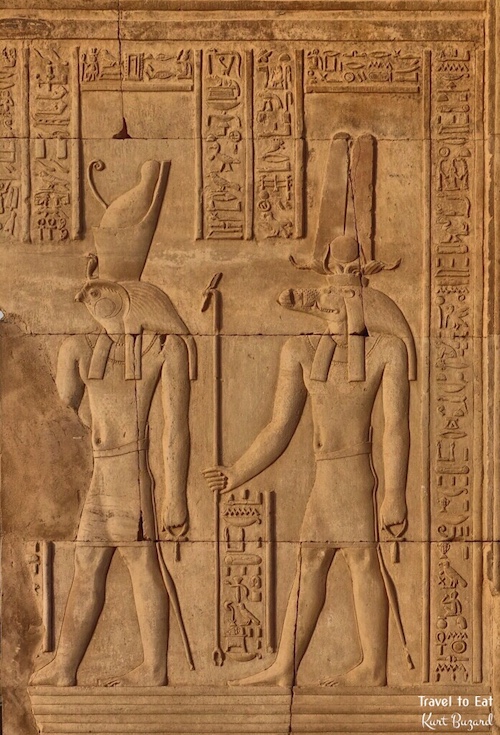
Though Sobek was worshipped in the Old Kingdom, he truly gained prominence in the Middle Kingdom (2055-1650 BCE), most notably under the Twelfth Dynasty king, Amenemhat III. Amenemhat III had taken a particular interest in the Faiyum region of Egypt, a region heavily associated with Sobek. Amenemhat and many of his dynastic contemporaries engaged in building projects to promote Sobek, projects that were often executed in the Faiyum. In this period, Sobek also underwent an important change, he was often fused with the falcon-headed god of divine kingship, Horus. This brought Sobek even closer with the kings of Egypt, thereby giving him a place of greater prominence in the Egyptian pantheon. The fusion added a finer level of complexity to the god’s nature, as he was adopted into the divine triad of Horus and his two parents: Osiris and Isis
Ptolemy VI Philometer (186-142 BCE)



The earliest king named in the temple at Kom Ombo is Ptolemy VI Philometor, though most of the decoration was completed by Ptolemy XII Neos Dionysos. In the early Roman Period the forecourt was decorated by Augustus and the outer corridor added. The family life of the ruling Greek Ptolemies was complicated. Cleopatra II was the daughter of Ptolemy V and Cleopatra I. She was the sister of Ptolemy VI and Ptolemy VIII Euergetes II Tryphon. She would eventually marry both of her brothers. Ptolemy succeeded in 180 BCE at the age of about 6 and ruled jointly with his mother, Cleopatra I, until her death in 176 BCE, which is what “Philometor”, his epithet, implies; “he who loves his mother”. The following year he married his sister, Cleopatra II, as it was customary for Pharaohs, for the Ptolemaic Greek kings had adopted many customs of the Pharaohs. He had at least four children with her: Ptolemy Eupator, Ptolemy Neos, Cleopatra Thea and Cleopatra III, and possibly Berenice. The woman behind Ptolemy VI may be his mother (Cleopatra I, his mother and regent) or Cleopatra II (his sister). I favor Cleopatra I since the symbol above her name includes an egg and flail rather than an egg and throne which would signify a queen. Also, note the actions of Haroeris in this relief, acting like Thoth with a quill, giving the temple (and it's responsibilities) to Ptolemy VI Philometor.
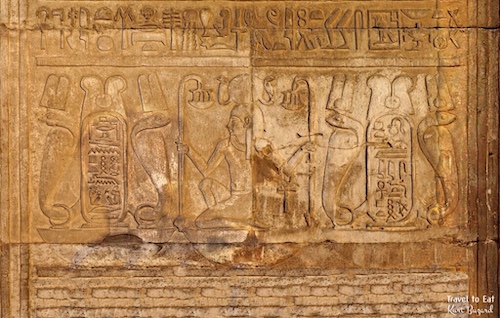
This lovely relief is meant to honor Ptolemy VI Philometer with his nomen and prenomen surrounded by uraeus. The Uraeus is the stylized, upright form of an Egyptian cobra (asp, serpent, or snake), used as a symbol of sovereignty, royalty, deity and divine authority in ancient Egypt. The Uraeous is a symbol for the goddess Wadjet. She was one of the earliest Egyptian deities and who often was depicted as a cobra. The subject of real interest in this depiction is the staff or scepter held by the pharaoh Ptolemy VI who is surmounted by a sun with double Uraeus. The staff looks like a temple on a staff, perhaps a reference to the divinity (and responsibility) of the pharaoh over Thoth.
Ptolemy VIII Euergetes II (182-162 BCE)



Ptolemy VIII's complicated political career started in 170 BC. This is when Antiochus IV Epiphanes of the Seleucid Empire (another product of the dissolution of Alexander the Great's empire) invaded and captured King Ptolemy VI Philometor and all of Egypt, with the exception of the city of Alexandria. Antiochus allowed Ptolemy VI to continue as a puppet monarch. Meanwhile, the people of Alexandria chose Ptolemy Euergetes, his younger brother, as king. Euergetes was popularly known as “Physkōn”, Latinized as Physcon, meaning sausage, potbelly or bladder, due to his obesity. After Antiochus withdrew from the area in 168 BC due to threats from Rome, Physcon agreed to jointly rule Egypt in a triumvirate with Philometor and Cleopatra II Epiphanes (Philometor's wife and their sister). In the relief shown above we see the triumvirate with Cleopatra II Epiphanes on the left, behind Ptolemy VIII (Physcon) and on the right we see an unnamed pharaoh who I think is Ptolemy VI Philometer. Between the triumvirate we see Haroeris and his consort Ta-Sent-Nefer, the “Good Sister” (another form of Hathor).




When Philometor died on a campaign in 145 BC, Cleopatra II Epiphanes quickly had her son proclaimed King Ptolemy VII. Physcon, however, returned from battle and proposed joint rule and marriage with Cleopatra II, both of which she accepted. He had the younger Ptolemy assassinated during the wedding feast and claimed the throne himself, as “Ptolemy VIII Euergetes II” (a name deliberately recalling his ancestor Ptolemy III Euergetes who founded the Serapeum in Alexandria), and had himself proclaimed pharaoh in 144 BC. Physcon seduced and married Cleopatra III (his wife's daughter) without divorcing Cleopatra II, who became infuriated. Many speculate that Physcon only married Cleopatra II because he was plotting to marry Cleopatra III when she became of marrying age. Numbering the Ptolemies is a modern invention; the Greeks distinguished them by epithet (nickname). Since older sources may give a number one higher or lower, epithets are the most reliable way of determining which Ptolemy is being referred to in any given case. Thus we see not one but two Cleopatra wives behind Ptolemy VIII Euergetes II.
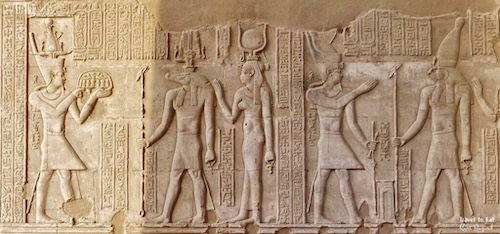
Here we see Ptolemy VIII Euergetes II alone facing Sobek-Re and Hathor on the left side of the above relief. On the right side Ptolemy VIII Euergetes II greets Horus.
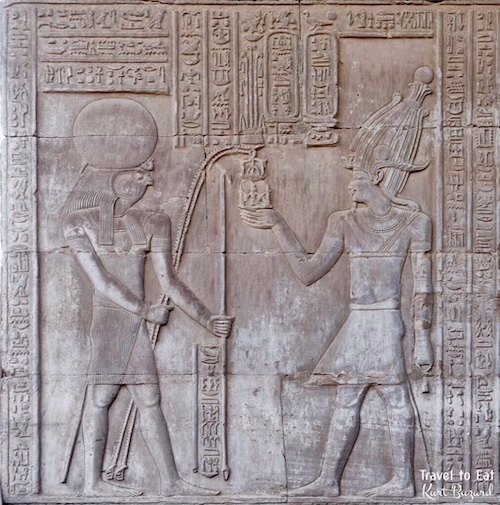
Here we see an unusual scene between Ptolemy VIII and Horesis. As god of wisdom and god of the moon, Thoth was one of the most important gods in the Egyptian pantheon. He supposedly created art, language, the alphabet, writing, religion, liturgical works, and the sciences, including numbers, astrology, astronomy, mathematics, geometry, surveying, medicine, and botany. He was also known as the “scribe of the gods.” In the Judgment Hall of the underworld after the deceased had spoken his negative confession (consisting of 42 things the person did not do in life), it was Thoth who gave the gods a final verdict on whether the soul should be blessed. Here it seems the temple and Maat are presented back to the pharaoh by Horesis.
Hapi, Sobek and the Pharaoh
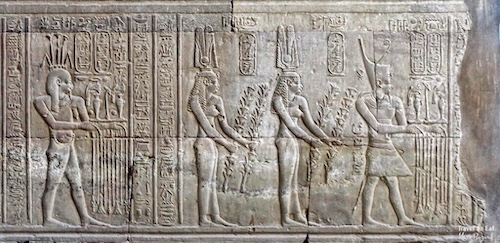
In another wall relief, Ptolemy VIII Euergetes II, backed by his two wives Cleopatra II and Cleopatra III precede Hapi, androgynous God of the annual Nile flood bearing gifts of the flood. Although male and wearing the false beard, Hapi was pictured with pendulous breasts and a large belly, as representations of the fertility of the Nile. He also was usually given blue or green skin, representing water. Other attributes varied, depending upon the region of Egypt in which the depictions exist. In Lower Egypt, he was adorned with papyrus plants and attended by frogs, present in the region, and symbols of it. Whereas in Upper Egypt, it was the lotus and crocodiles which were more present in the Nile, thus these were the symbols of the region, and those associated with Hapi there. Hapi never attained a high standing in the Egyptian pantheon of gods. Thus, it was the pharaoh who came to embody the responsibility for the annual Nile flood. Thus Hapi is shown here behind the pharaoh, Ptolemy VIII Euergetes II, supporting his efforts with the gods but secondary to the pharaoh in actually delivering the annual flood. Sobek inherited many of the attributes of Hapi by the Ptolemaic dynasties, it was said that his sweat was the the source of the Nile.
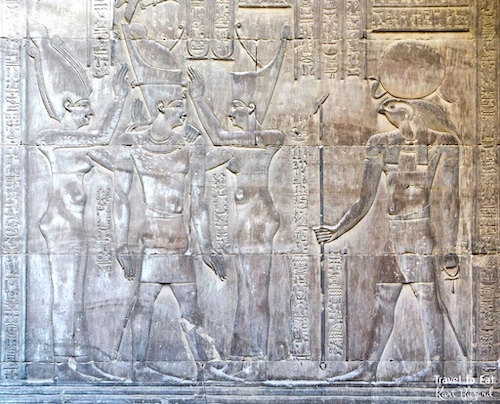
In ancient Egyptian texts, the “Two Ladies” was a religious euphemism for Wadjet and Nekhbet, the deities who were the patrons of the Ancient Egyptians and worshipped by all after the unification of its two parts, Lower and Upper Egypt. Wadjet (Uraeous, the rearing cobra) represented Lower Egypt and Nekhbet (the vulture) represented Nubia/Kush or Upper Egypt. As I have mentioned in an earlier post at the Temple of Horus at Edfu, Ptolemy is shown being crowned with the Peshent (crown of Upper and Lower Egypt) by actual women wearing the Deshret (crown of Lower Egypt) and the Hedjet (crown of Nubia/Kush or Upper Egypt). Here at Kom Ombo we see the same scene being re-enacted with actual naked women goddesses representing Wadjet and Nekhbet with Haroesis looking on. This is particularly ironic since Ptolemy VIII Euergetes II actually had two wives.
Ptolemy IX, X and XI



After the death of Ptolemy VIII in 116 BC Cleopatra III ruled jointly with her mother Cleopatra II and her son Ptolemy IX Soter II (Lathyros). Cleopatra III expelled Ptolemy IX from Alexandria in 107 BC and replaced him as co-regent with her second son Ptolemy X Alexander I. After 6 years of joint rule, Ptolemy X had his mother Cleopatra III murdered in 101 BC. Ptolemy IX first married his sister Cleopatra IV, by whom he had at least one son, the mother of Ptolemy XII and Ptolemy of Cyprus. Ptolemy IX then married his sister Cleopatra Selene, the mother of Berenice III. Ptolemy XI was born to Ptolemy X Alexander I and either Cleopatra Selene or Berenice III. His uncle Ptolemy IX Lathryos died in 81 BC or 80 BC, leaving no legitimate heir, and so Cleopatra Berenice (Berenice III) ruled alone for a time. Ptolemy XI married Cleopatra Berenice, who was his stepmother and half-sister (or possibly his natural mother). However, nineteen days after the marriage, Ptolemy XI murdered his bride for unknown reasons, an unwise move since Cleopatra Berenice was very popular, Ptolemy was immediately lynched by the citizens of Alexandria in 80 BCE.
Ptolemy XII Neo Dionysos (112-51 BCE)





When Ptolemy XI died without a male heir, the only available male descendents of the Ptolemy I lineage were the illegitimate sons of Ptolemy IX by an unknown Greek concubine. The boys were living in exile in Sinope, at the court of Mithridates VI, King of Pontus. As the eldest of the boys Ptolemy XII was proclaimed king as Ptolemy XII Neos Dionysos (nicknamed Auletes “the flute-player) and married his sister, Tryphaena. Ptolemy XII was coregent with his daughter Cleopatra VI Tryphaena and his wife Cleopatra V Tryphaena. Beyond the forecourt, the facade of the hypostyle hall built by Ptolemy XII, with its intercolumnar screen walls and small side doors for use by the priests, is typical of its period. On either side of the doors, Ptolemy XII Neo Dionysos is shown, with the Khepresh war time headdress, purified by Horus, Thoth and Haroeris (in the part on the left) and by Horus, Thoth and Sobek on the right. The capitals of the columns within, arranged in two rows of five free standing columns, are often wrought with ingenious compound forms. As would be expected, the decoration of the hall and remaining parts of the temple is divided between the two gods, with scenes of Sobek on the east and Haroeris on the west. The ceiling is decorated with astronomical scenes, with the vulture, the symbol of Nekhbet and Wadjet. The column shafts are all carved with reliefs: above with a band of hieroglyphs with the symbol of life (ankh) and below with the pharaoh rendering homage to the various gods.



This is easily the best preserved and most beautiful of the bas reliefs at Kom Ombo. Here we see Bast (or Bastet), the cat goddess, giving the “breath of life” to Ptolemy XII Neos Dionysos. Bastet was a goddess in ancient Egyptian religion, worshiped as early as the 2nd Dynasty (2890 BC). As Bast, she was the goddess of warfare in Lower Egypt, the Nile River delta region, before the unification of the cultures of ancient Egypt. Her name is also translated as Baast, Ubaste, and Baset. During the 22nd Dynasty (c. 945–715 BC), Bast had transformed from a lioness warrior deity into a major protector deity represented as a cat. Bastet, the name associated with this later identity, is the name commonly used by scholars today to refer to this deity. In Upper Egypt, Sekhmet was the parallel warrior lioness deity. Often similar deities merged into one with the unification, but that did not occur with these deities having such strong roots in their cultures. Instead, these goddesses began to diverge. Thoth, the scholar God, looks on as do Hathor, depicted as a cow goddess with horns in which is set a sun disk. She personified the principles of joy, feminine love, and motherhood. She was one of the most important and popular deities throughout the history of Ancient Egypt. Hathor was worshiped by royalty and common people alike in whose tombs she is depicted as “Mistress of the West” welcoming the dead into the next life. In other roles she was a goddess of music, dance, foreign lands and fertility who helped women in childbirth. Two forms of Horus or Haroeris are shown, one with the full crown of upper and lower Egypt and one with only the crown of upper Egypt, perhaps hinting at duality as Haroesis and Horus.


To the Egyptians, the most important human maintainer of maat is the pharaoh. In myth the pharaoh is the son of a variety of deities. As such, he is their designated representative, obligated to maintain order in human society just as they do in nature, and to continue the rituals that sustain them and their activities. The scepter of Thoth, consisting of two tcham (Was scepters) with an Ankh (often with hands) over a basket (neb meaning all) is the usual decoration of temples indicating a respect for Maat and the words written on the temple walls. At Kom Ombo we see an unusual decorative replacement with combination of a bird and bee preceded by a star (indicated as a disciple of the combination) over a basket (neb meaning all). I take this symbolism to be a union of Nekhbet (of upper Egypt) and the bee (of lower Egypt) or a disciple of the Union of upper and lower Egypt. Perhaps with the turmoil of the preceding years of Ptolemaic discord, this was a fitting wish.


Towards the left end of the rear wall, is the famous and controversial scene in which the king (Trajan) presents a group of ritual and/or surgical instruments. Some of these implements were certainly used in the practice of the cult, but other may very well be medically related. Furthermore, it is known that pilgrims came to Haroeris, Horus the Elder, who was also known as the healer, to be treated for their infirmities. They apparently waited on the god in the temple's hallways where game boards were scratched into the stones of the floor.
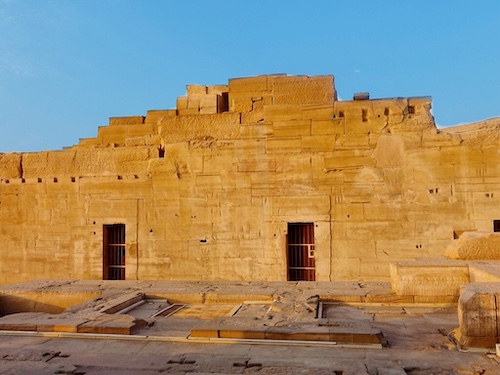
Crocodiles, which were sacred to Sobek, were thought to be bred in a small pool on the western side of the temple. Here you can also see remains of a very deep well with a circular staircase and a nilometer.
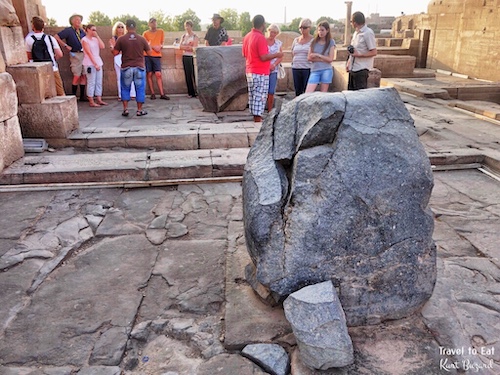
Dual alters complete the dual nature of the temple.
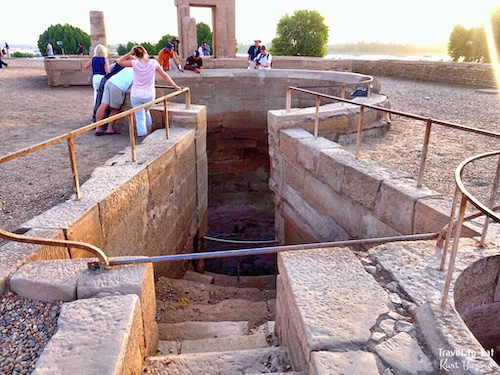
Almost every temple along the Nile has a nilometer. These served two functions, they allowed the priests to monitor the height of the Nile River and they brought fresh water to the temple. Since the temples were usually on a hill to avoid flooding, the wells were often quite deep. The nilometer at Kom Ombo is no exception, deep and large. Another reason to have a nilometer involves Egyptian mythology. Bringing the Nile inside the boundary of the temple cleanses the water and makes it holy.
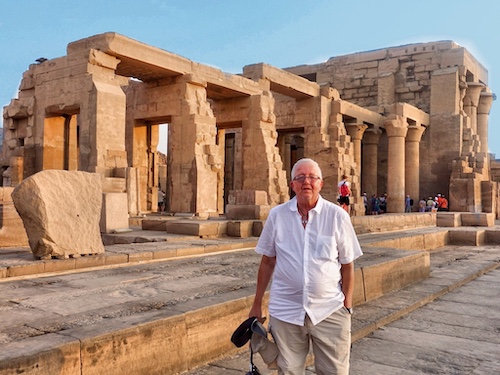
Thanks for visiting, please leave a comment.
[mappress mapid=”185″]
References:
Prehistoric Kom Ombo: http://gredos.usal.es/jspui/bitstream/10366/71004/1/New_Prehistoric_Investigations_at_Kom_Om.pdf
Sacred Destinations: http://www.sacred-destinations.com/egypt/kom-ombo
Tour Egypt: http://m.touregypt.net/featurestories/komombo2.htm
Ancient Greek Coins: http://www.edgarlowen.com/greek-coins-egypt.shtml
Ptolemy VI: http://m.touregypt.net/featurestories/ptolemy6.htm
Cleopatra I Syra: http://www.livius.org/cg-cm/cleopatra01/cleopatra_i_syra.html
Cleopatra II Livius: http://www.livius.org/cg-cm/cleopatra01/cleopatra_ii.html
Ptolemy XII: http://www.tyndalehouse.com/Egypt/ptolemies/ptolemy_xii.htm
Ptolemy XII Livius: http://www.livius.org/ps-pz/ptolemies/ptolemy_xii_auletes.html
Ptolemy X: http://www.tyndalehouse.com/egypt/ptolemies/ptolemy_x.htm
Ptolemy IX: http://www.tyndalehouse.com/Egypt/ptolemies/ptolemy_ix_fr.htm
Ancient Egyptian Medical Kit: http://www.landofpyramids.org/heka.htm

